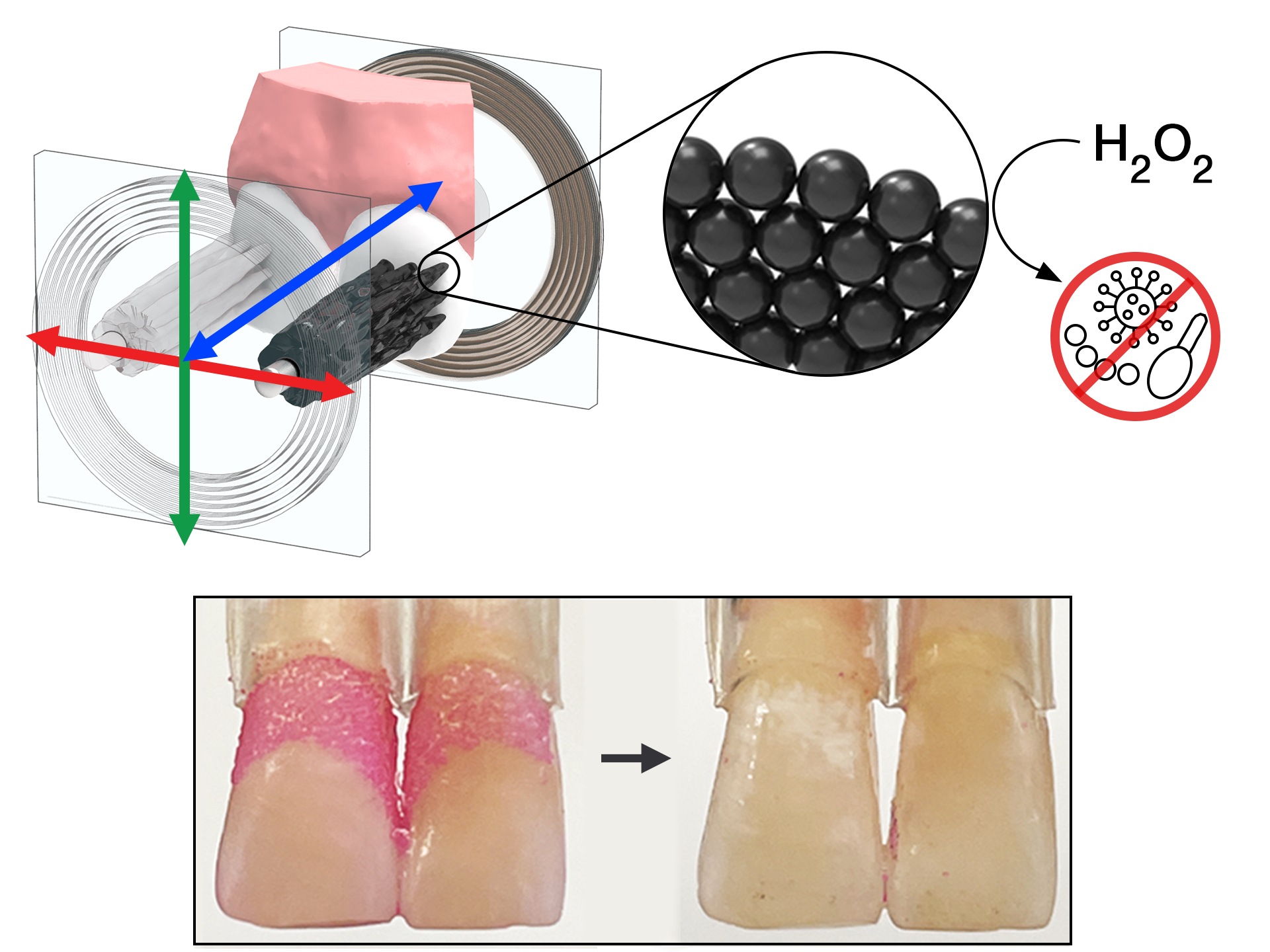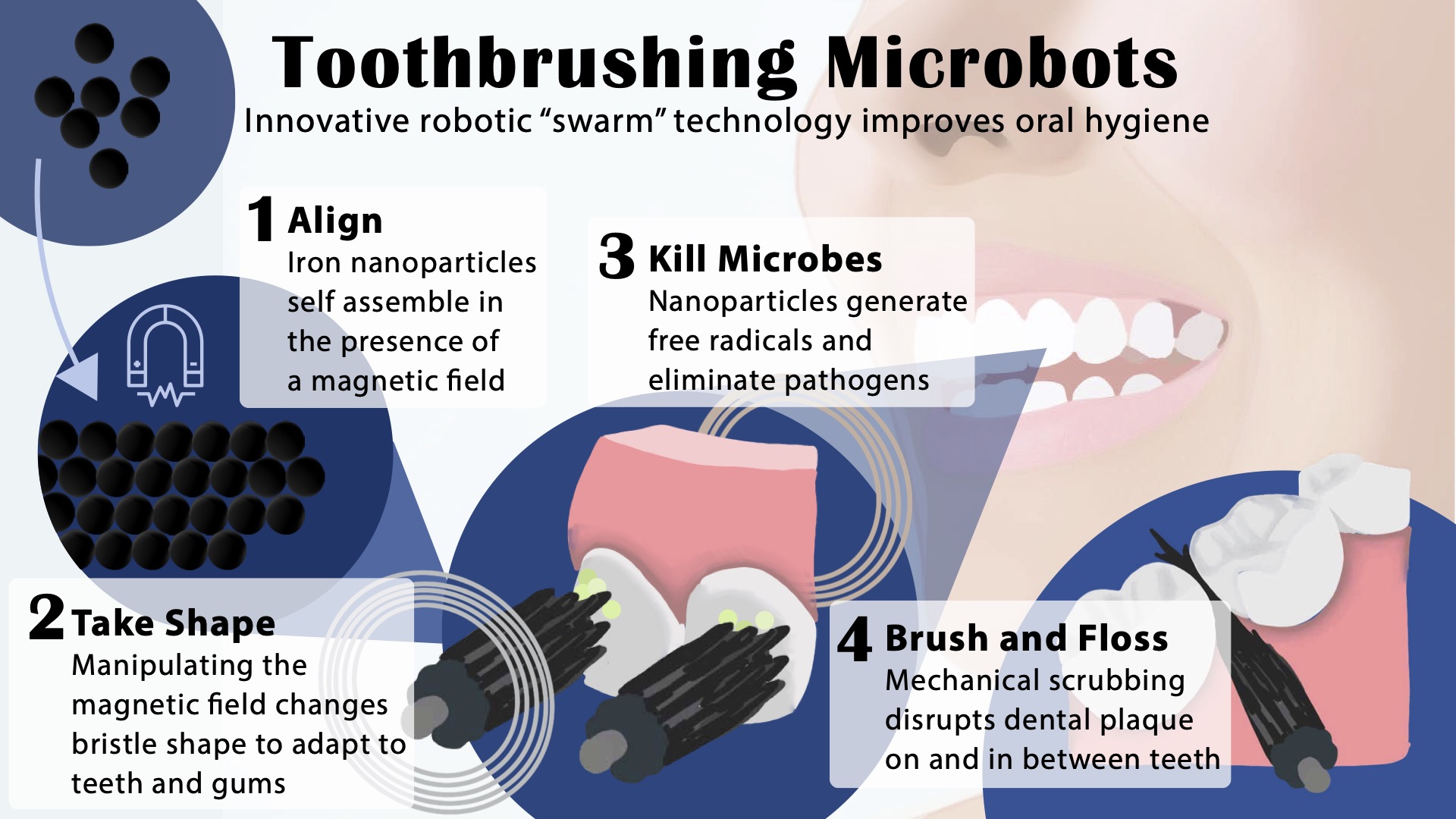创新背景
常规的口腔护理是繁琐的,尤其对那些很难清洁牙齿的人来说。机器人系统可以用一种单一的、免提的、自动化的方式完成这三件事。
创新过程
这些微型机器人的构件是氧化铁纳米颗粒,它具有催化和磁性活性。利用磁场,研究人员可以指导它们的运动和结构,形成刷毛状结构,扫掉牙齿表面的牙菌斑,或形成像牙线一样在牙齿之间滑动的细长线。在这两种情况下,催化反应驱动纳米颗粒产生抗微生物剂,杀死现场的有害口腔细菌。
在模拟和真实的人类牙齿上使用该系统进行的实验表明,机器人组件可以符合各种形状,几乎可以消除导致蛀牙和牙龈疾病的粘性生物膜。

纳米颗粒可以用磁场以令人惊讶的方式塑造和控制。研究人员制作的刷毛可以延伸、扫过,甚至可以在空间中来回移动,很像牙线。它的工作方式类似于机械臂伸出来清洁表面。该系统可通过编程自动进行纳米粒子组装和运动控制。
虽然增加了电动马达,提升了“棍子上的鬃毛”的基本形式,但基本概念仍然保持不变。这是一项几十年来从未被颠覆过的技术。
几年前,宾夕法尼亚大学创新与精密牙科中心(CiPD)的研究人员(Koo是该中心的联合主任)使用这种微型机器人系统,采取了重大的颠覆措施。
他们的创新源于一点机缘巧合。宾夕法尼亚大学牙科医学和工程学院的研究小组都对氧化铁纳米颗粒感兴趣,但原因截然不同。Koo的团队对纳米颗粒的催化活性很感兴趣。它们可以激活过氧化氢释放自由基,杀死导致蛀牙的细菌,并降解牙菌斑生物膜。与此同时,Steager和他的工程同事,包括Vijay Kumar院长和Kathleen Stebe教授,CiPD的联合主任,正在探索这些纳米颗粒作为磁性控制微型机器人的构建模块。

在宾夕法尼亚大学卫生技术学院和美国国立卫生研究院口腔和颅面研究所的支持下,宾夕法尼亚大学的合作者在目前的工作中结合了这两种应用,构建了一个电磁控制微型机器人的平台,使它们能够采用不同的配置,并在现场释放抗菌素,有效地治疗和清洁牙齿。
研究人员优化了微型机器人在一小块类似牙齿的材料上的运动。接下来,他们使用基于牙科诊所人类牙齿扫描的3D打印牙齿模型,测试微型机器人的性能,以适应牙齿表面、齿间表面和牙龈线的复杂地形。最后,他们在真正的人类牙齿上试验了微型机器人,这些牙齿被安装在模仿牙齿在口腔中的位置的方式上。
在这些不同的表面上,研究人员发现微型机器人系统可以有效地消除生物膜,清除所有可检测到的病原体。氧化铁纳米颗粒已被FDA批准用于其他用途,在动物模型上对猪鬃形成的测试表明,它们不会伤害牙龈组织。
事实上,该系统是完全可编程的;该团队的机器人专家和工程师利用磁场的变化来精确调整微型机器人的运动,并控制鬃毛的硬度和长度。研究人员发现,刷毛的尖端可以做得足够坚固,以去除生物膜,但又足够柔软,以避免损伤牙龈。
创新关键点
研究人员构建了一个电磁控制微型机器人的平台,使它们能够采用不同的配置,并在现场释放抗菌素,有效地治疗和清洁牙齿。
创新价值
这项技术是由宾夕法尼亚大学的一个多学科团队开发的,有望提供一种新的自动化方式来完成日常工作,如刷牙和用牙线清洁牙齿。这一系统对于那些缺乏灵活的手工来有效清洁牙齿的人来说有极高的价值。
Deformable micro-robots can be used to automate tooth treatment
The building blocks of these microbots are iron oxide nanoparticles, which are catalytically and magnetically active. Using magnetic fields, researchers can direct their movement and structure, creating brush-like structures that sweep plaque off the surface of teeth, or forming elongated lines that slide between teeth like dental floss. In both cases, the catalytic reaction drives the nanoparticles to produce antimicrobials that kill harmful oral bacteria in the field.
Experiments using the system on simulated and real human teeth have shown that robotic components can conform to a variety of shapes and can virtually eliminate the sticky biofilms that cause tooth decay and gum disease.
Nanoparticles can be shaped and controlled using magnetic fields in surprising ways. The researchers made bristles that could extend, sweep and even move back and forth in space, much like dental floss. It works like a robotic arm sticking out to clean a surface. The system can be programmed to automatically assemble and control the motion of nanoparticles.
Although the basic form of "Mane on a stick" has been lifted by the addition of an electric motor, the basic concept remains the same. It's a technology that hasn't been disrupted in decades.
A few years ago, researchers at the Center for Innovation and Precision Dentistry (CiPD) at the University of Pennsylvania (of which Koo is co-director) took a major step towards disruption by using this tiny robotic system.
Their innovation was born out of a bit of chance. The teams at Penn's Schools of Dental Medicine and Engineering were both interested in iron oxide nanoparticles, but for very different reasons. Koo's team is interested in the catalytic activity of nanoparticles. They can activate hydrogen peroxide to release free radicals that kill cary-causing bacteria and degrade plaque biofilms. In the meantime, Steager and his engineering colleagues, including Dean Vijay Kumar and Professor Kathleen Stebe, co-director of the CiPD, are exploring these nanoparticles as building blocks for magnetically controlled microrobots.
At the university of Pennsylvania and the United States national institutes of health oral health institute of technology and under the support of craniofacial research institute, university of Pennsylvania's partners in the present work is a combination of these two kinds of application, built a electromagnetic control of micro robot platform, allowing them to adopt different configuration, and the release of antimicrobial in site, effective treatment and clean your teeth.
The researchers optimized the movement of the tiny robot on a small piece of tooth-like material. Next, they used 3D-printed tooth models based on human tooth scans in dental clinics to test the performance of micro-robots to adapt to the complex terrain of tooth surfaces, interdental surfaces, and gum lines. Finally, they experimented with tiny robots on real human teeth, which were mounted in a way that mimicked the position of the teeth in the mouth.
On these different surfaces, the researchers found that the microrobot system could effectively eliminate biofilms, removing all detectable pathogens. The iron oxide nanoparticles have been approved by the FDA for other uses, and tests on bristle formation in animal models have shown that they do not harm gum tissue.
In fact, the system is fully programmable; The team's roboticists and engineers used changes in the magnetic field to precisely tune the movement of the tiny robot and control the stiffness and length of the mane. The researchers found that the tips of the bristles could be made strong enough to remove biofilm but soft enough to avoid damaging the gums.
智能推荐
国际研究团队利用人工智能发现心肌病患者体内的异常突变
2022-08-17研究团队对已知或未知遗传原因的心肌病患者以及无结构性心脏病对照组的心脏样本进行了单核RNA测序,确定了关键细胞类型及其在心脏中的位置、细胞相互作用和生物信号通路,为健康和疾病状态下的心脏生物学提供了见解。
涉及学科涉及领域研究方向创新“白盒”机器学习方法揭示抗生素作用机制
2022-08-16在一项关于抗生素作用的新研究中,麻省理工学院的研究人员开发了一种新的机器学习方法,以发现一种帮助某些抗生素杀死细菌的额外机制。这一次要机制涉及激活细菌的核苷酸代谢,而这些核苷酸是细胞复制DNA所需的。利用这一机制可以帮助研究人员发现能够与抗生素一起使用的新药物,以增强它们的杀伤能力。这篇研究论文发表在《细胞》杂志上。
涉及学科涉及领域研究方向物联网技术创新 | 弹性粘合剂配对传感器创新超声成像设备
2022-07-29结合弹性粘合剂和刚性传感器制作超声成像贴纸,弹性体延长贴纸监测时间,为医疗成像技术拓展新方法。
涉及学科涉及领域研究方向生物研究者通过获取肿瘤特异性肽开发癌症治疗新技术
2022-09-01研究创造性地将胸腔积液用于确定HLA结合肽库的科学用途,从胸腔积液中获取肿瘤肽的能力或许可以为晚期癌症的治疗开辟新的途径。
涉及学科涉及领域研究方向